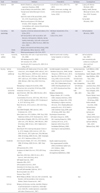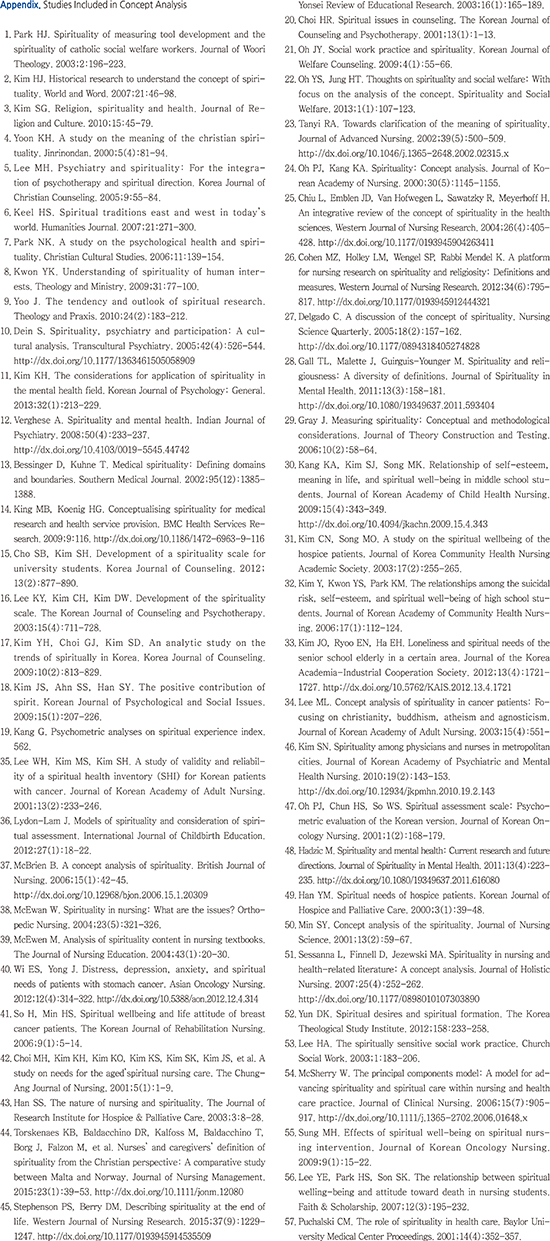This article has been corrected. See "Corrigendum: Evolutionary Concept Analysis of Spirituality" in Volume 47 on page 712.
Abstract
Methods
Rodgers's evolutionary concept analysis was used to analyze fifty seven studies from the literature related to spirituality as it appears in systematic literature reviews of theology, medicine, counseling & psychology, social welfare, and nursing.
Results
Spirituality was found to consist of two dimensions and eight attributes: 1) vertical dimension: ‘intimacy and connectedness with God’ and ‘holy life and belief’, 2) horizontal dimension: ‘self-transcendence’, ‘meaning and purpose in life’, ‘self-integration’, and ‘self-creativity’ in relationship with self, ‘connectedness’ and ‘trust’ in relationship with others·neighbors·nature. Antecedents of spirituality were socio-demographic, religious, psychological, and health related characteristics. Consequences of spirituality were positive and negative. Being positive included ‘life centered on God’ in vertical dimension, and among horizontal dimension ‘joy’, ‘hope’, ‘wellness’, ‘inner peace’, and ‘self-actualization’ in relationship with self, ‘doing in love’ and ‘extended life toward neighbors and the world’ in relationship with others·neighbors·nature. Being negative was defined as having ‘guilt’, ‘inner conflict’, ‘loneliness’, and ‘spiritual distress’. Facilitators of spirituality were stressful life events and experiences.
Conclusion
Spirituality is a multidimensional concept. Unchangeable attributes of spirituality are ‘connectedness with God’, ‘self-transcendence’, ‘meaning of life’ and ‘connectedness with others·nature’. Unchangeable consequences of spirituality are ‘joy’ and ‘hope’. The findings suggest that the dimensional framework of spirituality can be used to assess the current spiritual state of patients. Based on these results, the development of a Korean version of the scale measuring spirituality is recommended.
Figures and Tables
Table 1
Concept Analysis of Spirituality in Studies

Table 2
Integrated Results of Concept Analysis of Spirituality

Notes
References
1. Meehan TC. Spirituality and spiritual care from a careful nursing perspective. J Nurs Manag. 2012; 20(8):990–1001. DOI: 10.1111/j.1365-2834.2012.01462.x.
2. Nightingale F. Sick nursing and health nursing. In : Hampton I, editor. Nursing the sick. New York, NY: McGraw-Hill;1893. p. 24–43.
3. Kim SG. Religion, spirituality and health. J Relig Cult. 2010; 15:45–79.
4. Monod S, Brennan M, Rochat E, Martin E, Rochat S, Bula CJ. Instruments measuring spirituality in clinical research: A systematic review. J Gen Intern Med. 2011; 26(11):1345–1357. DOI: 10.1007/s11606-011-1769-7.
5. Gall TL, Malette J, Guirguis-Younger M. Spirituality and religiousness: A diversity of definitions. J Spirit Ment Health. 2011; 13(3):158–181. DOI: 10.1080/19349637.2011.593404.
6. Taylor EJ. Nurses caring for the spirit: Patients with cancer and family caregiver expectations. Oncol Nurs Forum. 2003; 30(4):585–590. DOI: 10.1188/03.onf.585-590.
7. Reed PG. An emerging paradigm for the investigation of spirituality in nursing. Res Nurs Health. 1992; 15(5):349–357.
8. Religious Dictionary Composition Committee. The great encyclopedia of religious science. [Internet]. Seoul: Korea Dictionary Research Publishing;1998. cited 2016 Febrary 16. Available from: http://terms.naver.com/entry.nhn?docId=630458&cid=50766&categoryId=50794.
9. Burkhardt MA. Spirituality: An analysis of the concept. Holist Nurs Pract. 1989; 3(3):69–77.
10. Villagomeza LR. Spiritual distress in adult cancer patients: Toward conceptual clarity. Holist Nurs Pract. 2005; 19(6):285–294.
11. Hermann CP. Spiritual needs of dying patients: A qualitative study. Oncol Nurs Forum. 2001; 28(1):67–72.
12. NANDA International.
IS Ko
RY Song
EG Oh
. Nursing diagnoses 2015-17: Definitions and classification. 10th ed. Chichester/Ames, IA: Wiley-Blackwell;2014. p. 375.
13. Highfield ME. Providing spiritual care to patients with cancer. Clin J Oncol Nurs. 2000; 4(3):115–120.
14. Kang SR. Concept analysis of spiritual care. J Korean Acad Nurs. 2006; 36(5):803–812.
15. Azarsa T, Davoodi A, Khorami Markani A, Gahramanian A, Vargaeei A. Spiritual wellbeing, attitude toward spiritual care and its relationship with spiritual care competence among critical care nurses. J Caring Sci. 2015; 4(4):309–320. DOI: 10.15171/jcs.2015.031.
16. Brown AE, Whitney SN, Duffy JD. The physician's role in the assessment and treatment of spiritual distress at the end of life. Palliat Support Care. 2006; 4(1):81–86.
17. Caldeira S, Carvalho EC, Vieira M. Spiritual distress-proposing a new definition and defining characteristics. Int J Nurs Knowl. 2013; 24(2):77–84. DOI: 10.1111/j.2047-3095.2013.01234.x.
18. Kim KM, Lee BS. The conceptual analysis of spirituality. J Korean Acad Adult Nurs. 1998; 10(3):460–468.
19. Oh PJ, Kang KA. Spirituality: Concept analysis. J Korean Acad Nurs. 2000; 30(5):1145–1155.
20. Min SY. Concept analysis of the spirituality. J Nurs Sci. 2001; 13(2):59–67.
21. Reed PG. Spirituality and well-being in terminally ill hospitalized adults. Res Nurs Health. 1987; 10(5):335–344.
22. Tanyi RA. Towards clarification of the meaning of spirituality. J Adv Nurs. 2002; 39(5):500–509. DOI: 10.1046/j.1365-2648.2002.02315.x.
23. Reinert KG, Koenig HG. Re-examining definitions of spirituality in nursing research. J Adv Nurs. 2013; 69(12):2622–2634. DOI: 10.1111/jan.12152.
24. Sessanna L, Finnell D, Jezewski MA. Spirituality in nursing and health-related literature: A concept analysis. J Holist Nurs. 2007; 25(4):252–262. DOI: 10.1177/0898010107303890.
25. Rodgers B. Concept analysis: An evolutionary view. In : Rodgers B, Knafl K, editors. Concept development in nursing: Foundations, techniques and applications. 2nd ed. Philadelphia, PA: W. B. Saunders;2000. p. 77–102.
26. Howden J. Development and psychometric characteristics of the spirituality assessment scale [dissertation]. Denton, TX: Texas Woman's University;1992. 1–155.
27. Weathers E, McCarthy G, Coffey A. Concept analysis of spirituality: An evolutionary approach. Nurs Forum. 2016; 51(2):79–96. DOI: 10.1111/nuf.12128.
28. Marcoen A. Spirituality and personal well-being in old age. Ageing Soc. 1994; 14(4):521–536. DOI: 10.1017/S0144686X00001896.
29. Keel HS. Spiritual traditions east and west in today's world. Humanit J. 2007; 21:271–300.
30. Kim KH. The considerations for application of spirituality in the mental health field. Korean J Psychol Gen. 2013; 32(1):213–229.




 PDF
PDF ePub
ePub Citation
Citation Print
Print





 XML Download
XML Download